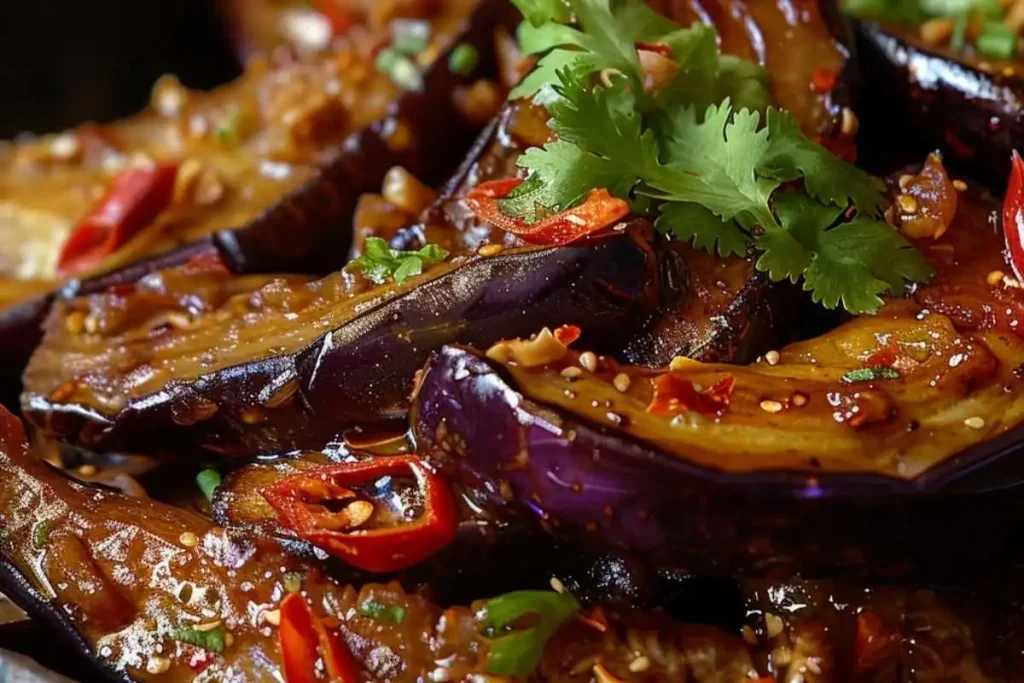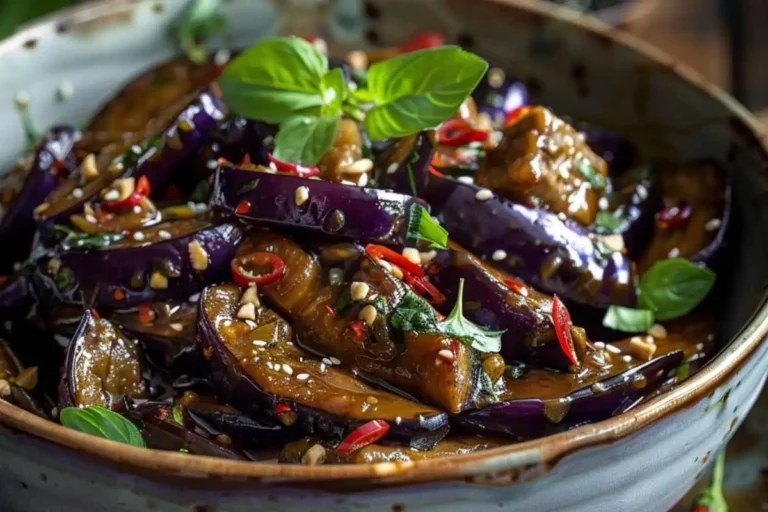Explore the vibrant flavors of Thailand with this easy and authentic Thai eggplant recipe. Perfect for anyone looking to dive into Thai cooking, this guide covers everything from selecting the right ingredients to serving suggestions. Whether you’re a seasoned chef or a curious foodie, this recipe will bring a taste of Thailand right to your kitchen!
Table of Contents
- Understanding Thai Eggplant
- Essential Ingredients for Thai Eggplant Recipe
- Step-by-Step Thai Eggplant Recipe
- Variations of the Thai Eggplant Recipe
- Serving and Pairing Suggestions
- Storing and Reheating
- Conclusion
- FAQ
Understanding Thai Eggplant
What is Thai Eggplant?
Thai eggplant, or makua puong, is a unique variety of eggplant native to Southeast Asia. It’s markedly different from its larger, more familiar Western counterparts, boasting a smaller size, round shape, and a green color speckled with white. The flavor is subtly bitter and slightly sweet, perfect for absorbing the rich spices common in Thai cooking.
Health Benefits of Thai Eggplant
Thai eggplant is not only a staple in Thai cuisine but also a powerhouse of nutrition. It’s low in calories but rich in fibers and antioxidants. Regular consumption can contribute to better heart health, reduced cholesterol levels, and increased digestive health. The presence of antioxidants like nasunin helps protect cells from damage, making Thai eggplant a healthy choice for an everyday diet.
Where to Buy Thai Eggplant
Finding Thai eggplant might be a challenge depending on where you live. Look for them in Asian or specialty markets. For those unable to locate them, small Italian or Japanese eggplants make reasonable substitutes, although they are slightly larger and less bitter.
Essential Ingredients for Thai Eggplant Recipe
Key Ingredients Overview
For an authentic Thai eggplant dish, you will need the following essential ingredients:
- Thai eggplants: Small and round, these are the star of the dish.
- Coconut milk: Adds creaminess and sweet, nutty flavors.
- Thai basil: Provides a unique anise-like flavor.
- Fish sauce: Delivers umami and saltiness, essential for the depth of the dish.
- Chilies: For that characteristic Thai heat.
- Garlic and shallots: They lay the foundational flavors.
Each of these ingredients plays a vital role in creating the complex flavor profile typical of Thai cuisine.
Recommended Thai Spices and Herbs
The spices and herbs you choose can make or break your Thai eggplant recipe. Here are some essentials:
- Lemongrass: Infuses the dish with a fresh, lemony scent.
- Kaffir lime leaves: Impart a tangy and aromatic flavor.
- Galangal: Similar to ginger but sharper and more citrusy.
- Coriander: The seeds are used for their nutty, spicy taste, and the leaves for garnishing.
These ingredients are crucial for achieving that authentic Thai flavor, so try not to skip them!
Preparing Your Ingredients
Before you begin cooking, it’s essential to prepare your ingredients properly:
- Wash and cut the eggplants into halves or quarters, depending on their size. Soak them in water to prevent browning.
- Chop the herbs finely to release more flavor.
- Prepare the spice paste, if using, by blending lemongrass, galangal, garlic, shallots, and chilies into a fine mix.
Proper preparation ensures that the cooking process is smooth and that the flavors meld beautifully.
Step-by-Step Thai Eggplant Recipe
Preparing the Eggplant
To prepare the Thai eggplant:
- Slice the eggplants into manageable pieces, not too thin to avoid mushiness during cooking.
- Salt the pieces lightly and let them sit for about 10 minutes. This step helps draw out some of the natural bitterness.
- Rinse under cold water and pat dry.
This preparation ensures that the eggplants are ready to perfectly absorb all the flavors of the spices and seasonings they will be cooked with.
Cooking Techniques
Thai eggplant is versatile and can be cooked using various techniques:
- Stir-frying: Quick and easy, it allows the eggplant to absorb the sauce and spices well.
- Grilling: Gives a smoky flavor that pairs wonderfully with the sweetness of the coconut milk.
- Steaming: For a softer, more delicate texture.
Choose a method that suits your taste preference and the tools you have available.
Assembling the Dish
Once your ingredients are prepared and your cooking method is decided, it’s time to cook:
- Heat oil in a pan over medium heat and sauté garlic and shallots until fragrant.
- Add the prepared spice paste and fry until it starts to separate from the oil.
- Introduce the Thai eggplants, stirring to coat them in the spice mixture.
- Pour in coconut milk and bring to a simmer.
- Add fish sauce and sugar for seasoning.
- Simmer until the eggplants are tender but still hold their shape.
- Stir in Thai basil and remove from heat.
The dish should be creamy, with a rich and complex flavor profile, balancing spicy, salty, sweet, and umami.
Variations of the Thai Eggplant Recipe
Vegan and Vegetarian Options
To accommodate vegan and vegetarian diets, you can easily modify the traditional Thai eggplant recipe:
- Replace fish sauce with soy sauce or a vegan fish sauce alternative to maintain the umami flavor.
- Use tofu or tempeh as a protein substitute, adding it to the dish just like you would with meat options.
These substitutions ensure that everyone can enjoy this delicious dish, regardless of dietary restrictions.
Adding Proteins
For those looking to add more protein to their meal, Thai eggplant pairs wonderfully with a variety of protein sources:
- Chicken: Add cubed chicken breast at the same time as the eggplants to ensure it cooks thoroughly.
- Beef: Thinly sliced beef can be added for a richer flavor; make sure to adjust cooking times accordingly.
- Seafood: Shrimp or scallops are excellent additions; add them near the end of cooking to avoid overcooking.
Including these proteins transforms the dish into a heartier meal, making it suitable for larger appetites or as a standalone dish.
Regional Variations
Thai eggplant recipe can vary significantly from one region of Thailand to another:
- Northern Thailand: Here, the dish might include more robust spices and less coconut milk.
- Southern Thailand: Expect a creamier version, often hotter and with more pronounced flavors of turmeric and tamarind.
Exploring these regional differences can be a delightful way to understand the diversity of Thai cuisine and adjust the recipe to suit your flavor preferences.

Serving and Pairing Suggestions
How to Serve Thai Eggplant
Thai eggplant is best served hot and can be presented beautifully with a few simple touches:
- Garnish with additional Thai basil leaves and a sprinkle of red chili flakes for color and heat.
- Serve alongside a bowl of steamed jasmine rice or rice noodles to complement the rich flavors of the eggplant dish.
This presentation not only enhances the visual appeal but also the eating experience, allowing the flavors to shine through more vividly.
Pairing with Other Dishes
To create a fuller Thai meal experience, consider pairing the Thai eggplant with other dishes such as:
- Thai cucumber salad for a refreshing contrast.
- Grilled chicken satay or fish cakes as a protein-rich side.
- Sticky rice to absorb the delicious sauces and enhance the meal’s texture.
These combinations make for a well-rounded meal, showcasing the variety and richness of Thai culinary traditions.
Storing and Reheating
Best Practices for Storage
To keep leftover Thai eggplant tasting fresh:
- Allow the dish to cool to room temperature before sealing it in an airtight container.
- Refrigerate for up to 3-4 days.
Proper storage is crucial to maintaining the dish’s flavor and preventing spoilage.
Tips for Reheating
When it comes to reheating, gentle methods work best to preserve the texture and flavor of Thai eggplant:
- Microwave: Use a low power setting and stir occasionally.
- Stovetop: Reheat slowly on low heat, adding a little extra coconut milk or water if the dish seems dry.
These methods help ensure that the reheated dish is nearly as good as when it was freshly made.
Conclusion
Creating this Thai eggplant recipe at home is more than just a cooking activity; it’s an opportunity to explore and enjoy the vibrant flavors of Thai cuisine. Whether you stick to the traditional method or experiment with variations, this dish is sure to impress with its depth of flavor and beautiful presentation.
We’d love to hear how your Thai eggplant turned out! Feel free to share your experiences, modifications, or any tips you discovered along the way in the comments below. Don’t forget to follow us for more tasty recipes and culinary insights!
Frequently Asked Questions (FAQ)
What is Thai eggplant good for?
Thai eggplant is not only a staple in traditional Thai cooking but also offers numerous health benefits. It is low in calories but high in fiber, which can aid in digestion and help maintain a healthy weight. Thai eggplant is also rich in antioxidants, which help combat oxidative stress and may reduce the risk of chronic diseases such as heart disease and diabetes. Additionally, its versatile flavor and texture make it ideal for absorbing the rich spices and flavors typical in Thai cuisine, making it a fantastic ingredient for a variety of dishes.
What kind of eggplant is used in Thai food?
The type of eggplant most commonly used in Thai cuisine is known as Thai eggplant, or makua puong in Thai. It is small and round, usually green or white with green stripes, and significantly different from the large purple varieties commonly used in Western cooking. Thai eggplants have a slightly bitter and sweet taste and are ideal for cooking methods like stir-frying, steaming, and grilling, which are popular in Thai recipes.
Is the skin of a Thai eggplant edible?
Yes, the skin of Thai eggplant is entirely edible. Unlike larger, Western varieties of eggplant, which can sometimes have tough skins, Thai eggplants have thinner, tender skins that cook quickly. The skin helps to hold the eggplant together during cooking, ensuring that the pieces don’t fall apart in the dish and retain more of their nutrients.
How do you take care of Thai eggplant?
Caring for Thai eggplant involves several important steps:
- Climate: Thai eggplant thrives in warm, humid climates. If you live in a cooler area, consider growing it in a greenhouse or indoors if possible.
- Sunlight: They require full sun, so ensure they get at least 6-8 hours of direct sunlight daily.
- Soil: Use well-draining soil rich in organic matter. Ideally, the pH level should range from 5.5 to 6.5.
- Watering: Keep the soil consistently moist. Water the plants deeply but infrequently to encourage strong root development.
- Fertilization: Apply a balanced fertilizer regularly, especially during the growing season, to support healthy growth and fruit production.
- Pest Management: Monitor for pests like aphids and spider mites. Use organic pesticides if necessary to keep pests under control without harming the plant.
Why do you soak eggplant before cooking?
Soaking eggplant, particularly Thai eggplant, before cooking can serve several purposes:
- Reduce Bitterness: Soaking helps to leach out some of the natural bitterness from the eggplant, particularly from the seeds.
- Reduce Oil Absorption: Eggplant is like a sponge when it comes to oil. Soaking can help fill some of the air spaces in the eggplant’s flesh, reducing the amount of oil it absorbs during cooking.
- Maintain Color: For some varieties of eggplant, soaking in water with a little salt can help keep the flesh from browning too quickly when exposed to air.

Thai Eggplant with Basil & Coconut Curry
- Total Time: 30 minutes
- Yield: Serves 4
Description
This Thai eggplant recipe is perfect for a quick weeknight dinner that brings a taste of Thailand into your kitchen. Enjoy the rich flavors and aromatic presence of this delightful dish!
Ingredients
- 400g Thai eggplants (about 4–5 small ones), quartered
- 1 red bell pepper, thinly sliced
- 1 tablespoon vegetable oil
- 2 cloves garlic, minced
- 1 tablespoon fresh ginger, grated
- 2 tablespoons Thai red curry paste
- 1 can (400 ml) coconut milk
- 2 tablespoons fish sauce (use soy sauce for a vegetarian version)
- 1 tablespoon brown sugar
- 1/2 cup Thai basil leaves
- 1 tablespoon lime juice
- Optional: 200g tofu or chicken breast, cubed (for adding protein)
Instructions
- Prepare the Ingredients:
- Wash and quarter the Thai eggplants. Soak them in water for about 10 minutes to remove some bitterness.
- If using protein (tofu or chicken), prepare and set aside.
- Cook the Eggplant:
- Heat oil in a large skillet or wok over medium heat.
- Add garlic and ginger, sauté for about 1 minute until fragrant.
- Stir in the red curry paste and cook for another minute.
- Add the Main Ingredients:
- Drain the eggplants and add them to the skillet along with the red bell pepper.
- If adding protein, add it now and cook until it starts to brown slightly.
- Simmer the Curry:
- Pour in the coconut milk, fish sauce, and brown sugar. Stir well to combine.
- Bring to a light simmer, reduce heat, and let cook for about 10-15 minutes, or until the eggplant is tender and the protein is fully cooked.
- Finish with Freshness:
- Just before removing from heat, stir in the Thai basil leaves and lime juice.
- Serve:
- Serve hot over steamed jasmine rice.
Notes
- Adjust the amount of curry paste to suit your taste preference for heat.
- If you prefer a vegetarian dish, ensure to substitute fish sauce with soy sauce and skip any animal proteins.
- Prep Time: 10 minutes
- Cook Time: 20 minutes
- Cuisine: Thai
Nutrition
- Serving Size: Serves 4
- Calories: 250 kcal
- Sugar: 8 g
- Sodium: 900 mg
- Fat: 18 g
- Carbohydrates: 20 g
- Fiber: 5 g
- Protein: 6 g
Keywords: Thai eggplant dish, eggplant curry recipe, Thai aubergine curry
